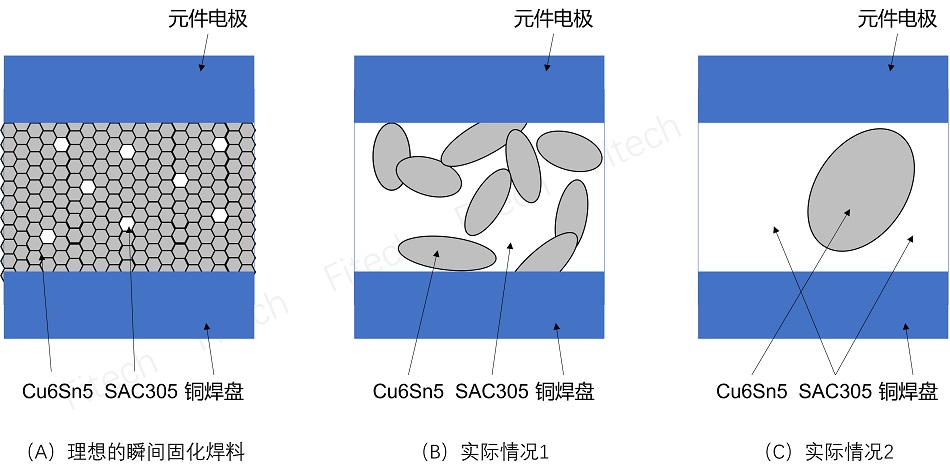High-Temperature Lead-Free Soldering - The Dream of The Global Solder Industry
The internal circuit connection of electronic components, especially power components, such as IGBT and other components with high current and high heat production has always been completed by SnPb95Ag2.5 solder alloy (alloy 925). This type of solder alloy has a high melting point of about 300°C. After the components are connected by utilizing this alloy solder, the solder joints produced for the connection of components and circuit boards can withstand the high reflow temperatures of conventional lead-free solders, such as SAC305, SAC105, SnSb10, etc. There are no extreme failure conditions such as solder joint remelting and reliability reduction. Hence, alloy 925 is a mature and reliable internal soldering material for components.
With the influence of lead-free soldering in the global electronic packaging industry, the internal connection solders of components are required to be lead-free. The deadline for the EU's exemption treaty for leaded soldering is getting closer and closer, raising the global solder industry's concern about high-temperature lead-free soldering. Seeking a lead-free but high melting point alloy to replace the existing alloy 925 has become the dream of the global solder industry. According to the phase diagram, gold-tin alloy Au80Sn20 is the only ideal binary tin-based alloy that meets the requirements. Au80Sn20 solder alloy is a eutectic alloy with a melting point of 280°C, which can replace alloy 925, but the high cost makes this alloy only used in some high-end photoelectric components and military supplies. Global scientists and engineers in the solder industry try to solve this problem in other ways. The main alternative methods are explained below.
①Sintered silver paste
The melting point of silver is 961°C. However, the metal powder in the micro and nano states mixed with resin can be melted at 250°C, followed by re-agglomerating after cooling. The melting point returns to 961°C on secondary heating. As a result, it can achieve the requirements of high-temperature lead-free soldering. The sintered silver paste has high thermal and electrical conductivity. It can realize the soldering of components under the pressurized or the non-pressurized condition to form high-reliability solder joints. This technology has been commercialized and has been recognized in the industry. However, the cost is higher. It is not a price equivalent to the traditional alloy 925, which affects the replacement.
②Sintered copper paste
The principle of copper sintering is similar to sintering silver paste. The nano-scale copper powder can reduce the copper melting point from 1083°C to about 250°C. The copper paste is sintered into solder joints, and the melting temperature returns to 1083°C. Hence, it can achieve the purpose of lead-free soldering. However, the sintered copper paste is still under research and development because of technical difficulties such as copper powder oxidation.
③ Instantaneous liquefaction and solidification of solder
Over the past 10 years, Instantaneous liquefaction and solidification of solder attracted the attention of the global solder industry. Many companies invested a lot of resources in research and development. The principle of this solder is that tin is highly corrosive to copper and its chemicals, so the solder melting process can be regarded as a micro-metallurgical process. Micron-copper and nano-copper particles or micron-Cu6Sn5 and nano-Cu6Sn5 are added to SAC305 tin-based solder alloy to form a mixture. In the molten state of SAC305, a micro-metallurgical process is realized with the added copper powder and copper compound powder, and the solder joints mainly composed of Cu6Sn5 are formed. The melting point of Cu6Sn5 is 420°C, which makes the composite solder joint melting temperature (300-400°C) no longer the same as that of SAC305 (217°C). The internal solder joints of the components formed by this mixed solder can fully meet the secondary reflow temperature requirements of the circuit board assembly.
This ideal state of micro-metallurgy has attracted scientists from the United States, Japan, Germany, and China for more than ten years. However, this technology has not been put into industrial application due to the factors such as the control of the micro-metallurgy state, the chemical reaction state of copper powder, and others. The application is still in the development process.

Fitech, as the world's leading manufacturer of ultra-fine solder, has reasonably launched a lead-free secondary reflow soldering scheme using conventional SAC305 instead of alloy 925 after a lot of research and development and application practice by scientists and application engineers. The feature of this solution is that the SAC305 solder is used for the second reflow. The proven SAC305 solder can meet the high thermal conductivity and electrical conductivity requirements for the solder joints. It is practicable for the packaging process. Chinese patented FL200 solder developed by Fitech is available for the secondary reflow soldering of components and circuit boards. The maximum reflow temperature of the solder is less than 200°C. In the packaged components, the melting point of the SAC305 solder is below 217°C. Therefore, FL200 will not affect the component reliability. This low-temperature solder can have 80%-90% of the shear force of SAC305. Moreover, the FL200 solder has similar drop resistance and soldering reliability to that of SAC305, which has been tested and approved by the global solder industry. The scheme of secondary reflow soldering with reduced temperature developed by Fitech is another way to realize the high-temperature lead-free soldering dream of the global solder industry.












 Back to list
Back to list



